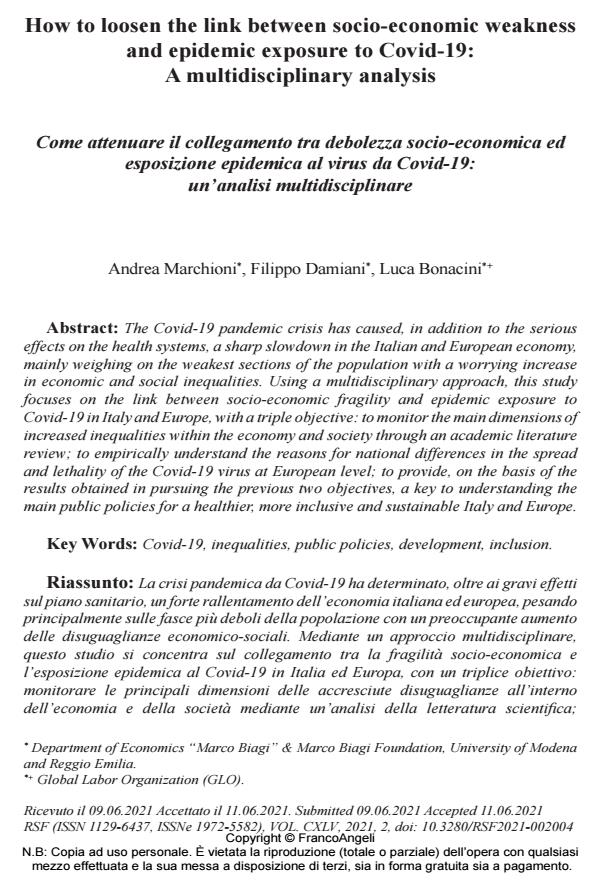How to loosen the link between socio-economic weakness and epidemic exposure to Covid-19: A multidisciplinary analysis
Titolo Rivista RIVISTA SPERIMENTALE DI FRENIATRIA
Autori/Curatori Andrea Marchioni, Filippo Damiani, Luca Bonacini
Anno di pubblicazione 2021 Fascicolo 2021/2
Lingua Inglese Numero pagine 16 P. 37-52 Dimensione file 188 KB
DOI 10.3280/RSF2021-002004
Il DOI è il codice a barre della proprietà intellettuale: per saperne di più
clicca qui
Qui sotto puoi vedere in anteprima la prima pagina di questo articolo.
Se questo articolo ti interessa, lo puoi acquistare (e scaricare in formato pdf) seguendo le facili indicazioni per acquistare il download credit. Acquista Download Credits per scaricare questo Articolo in formato PDF

FrancoAngeli è membro della Publishers International Linking Association, Inc (PILA)associazione indipendente e non profit per facilitare (attraverso i servizi tecnologici implementati da CrossRef.org) l’accesso degli studiosi ai contenuti digitali nelle pubblicazioni professionali e scientifiche
The Covid-19 pandemic crisis has caused, in addition to the serious effects on the health systems, a sharp slowdown in the Italian and European economy, mainly weighing on the weakest sections of the population with a worrying increase in economic and social inequalities. Using a multidisciplinary approach, this study focuses on the link between socio-economic fragility and epidemic exposure to Covid-19 in Italy and Europe, with a triple objective: to monitor the main dimensions of increased inequalities within the economy and society through an academic literature review; to empirically understand the reasons for national differences in the spread and lethality of the Covid-19 virus at European level; to provide, on the basis of the results obtained in pursuing the previous two objectives, a key to understanding the main public policies for a healthier, more inclusive and sustainable Italy and Europe.
La crisi pandemica da Covid-19 ha determinato, oltre ai gravi effetti sul piano sanitario, un forte rallentamento dell’economia italiana ed europea, pesando principalmente sulle fasce più deboli della popolazione con un preoccupante aumento delle disuguaglianze economico-sociali. Mediante un approccio multidisciplinare, questo studio si concentra sul collegamento tra la fragilità socio-economica e l’esposizione epidemica al Covid-19 in Italia ed Europa, con un triplice obiettivo: monitorare le principali dimensioni delle accresciute disuguaglianze all’interno dell’economia e della società mediante un’analisi della letteratura scientifica; comprendere empiricamente le ragioni delle differenze nazionali nella diffusione e letalità del virus da Covid-19 a livello europeo; fornire, sulla base dei risultati ottenuti nel perseguimento dei precedenti due obiettivi, una chiave di lettura delle principali politiche pubbliche per un’Italia ed un’Europa più sane, inclusive e sostenibili.
Parole chiave:Covid-19, disuguaglianze, politiche pubbliche, sviluppo, inclusione.
Andrea Marchioni, Filippo Damiani, Luca Bonacini, How to loosen the link between socio-economic weakness and epidemic exposure to Covid-19: A multidisciplinary analysis in "RIVISTA SPERIMENTALE DI FRENIATRIA" 2/2021, pp 37-52, DOI: 10.3280/RSF2021-002004